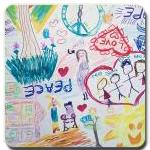Strengthening Families through Mindfulness


For many of us, the thought of bringing awareness to our thoughts and feelings for more than a couple of minutes may seem challenging. Committing to a true mindfulness practice on a regular basis seems even more daunting. However, at one point in our lives, we were all naturals.
According to Sara Marlowe, a Toronto-based mindfulness practitioner, children are amazingly quick and receptive to mindfulness activities.
“They don’t feel silly or judgmental about what they are doing,” she explains. “They can often be more open and engaged in the activities than adults.”
For the past five years, Marlowe has been working in the mental health field and delivering mindfulness workshops to children and parents in her community in order to open the hearts and minds of families and spread the benefits of such an important practice.
“The workshops are a launching pad where families can learn the practices and build on them at home,” says Marlowe.
Through fun, age-appropriate activities, using movement, song, stories and art, Marlowe connects children to how they are feeling and thinking and has them explore and express it in a positive, healthy way. She often provides concrete tools for them to use, such as putting a stone or stuffed animal on your belly to help draw attention to your breathing. Marlowe is also author of "No Ordinary Apple", a children's book that teaches the practice of mindful eating through story.
But mindfulness is not a fix-all practice warns Marlowe. “Parents sometimes look to mindfulness to fix their child’s behaviour, but the child has to gravitate toward it first. Instead, it’s about planting seeds.”
Mindfulness has many benefits. Many of the kids attending Marlowe’s workshops start from a place of social isolation. They may experience attachment issues or generally have difficulty getting along with peers. But whether it’s the group activities, the safe space that has been created, or the fun introspection, Marlowe says, “there is just something about these groups that helps them make friends.” In her longer programs that extend over a number of weeks, the sense of group cohesion is amazing.
According to Marlowe there are a number of key things to keep in mind when working with children in this way:
- Create a safe, exploratory space.
One of the most important things to do is set up an environment that is non-judgmental, non-competitive, and very compassionate.
“A lot of kids come with a story that they are bad,” says Marlowe, “that they are always getting into trouble. Parents try to stop the behaviour and it becomes more of a management thing.”
“In mindfulness, we meet kids wherever they are at. This means never saying that any one kid is wrong because that just shuts them down.”
Marlowe explains how she practices saying yes and exploring whatever the children offer with a beginner’s mind and then engaging with curiosity. This gives them the freedom to be silly, to be heard and to feel accepted.
When there is a need to intervene in a child’s behaviour she will talk about it as a group without judgment and be compasionate in how the group addresses the issue.
- Age appropriate exercises.
Marlowe stresses the importance of finding activities that are fun, non-competitive, and creative. They need to be simple enough to “thicken” the mindfulness concepts in an engaging way. You also need to figure out what’s going on in the room and assess the energy level before imposing a teaching agenda on the kids.
Some of Marlowe’s favourites include “The Seaweed Practice” and “Mind in a Jar”. The former involves moving like algae in a slow moving river and then speeding up and noticing what sensations they feel in their body. The latter gets the kids to create a representation of their mind using a clear container and some sand or glitter. When they shake it up it is a reminder of a busy mind that can’t see clearly and when it settles it shows a peaceful mind.
- Embody, embody, embody!
“There is research supporting that children can learn more and integrate concepts better by having a teacher or a significant adult in their life who is embodying compassion and non-reactivity,” explains Marlowe.
It is so important to be open to exploring whatever the child brings forward and have your own process in check.
This is why it is part of her programs to teach parents alongside the children. Marlowe equips them with neurobiology research, self-awareness practices, strategies and alternative perspectives on how to respond to their children’s behaviour in a non-reactive way.
“The shift in parents is one the biggest things I notice in these programs. They develop more patience to explore what’s going on with their child from a compassionate place instead of doing behaviour management or modifying the child.”
And sometimes apologizing is the best thing. “It can be such a healing experience for children to know when parents recognize that they didn’t handle a situation in an appropriate manner. Mindfulness really goes both ways.”
____________________________________________________________________________________
Courtney Lawrence is a freelance writer, researcher, innovation consultant and yoga instructor. She has a passion for sharing human stories and building connections between groups of people. She has her own blog that explores spirituality and social relationships. www.courtneylawrence.ca







Comments
Post new comment